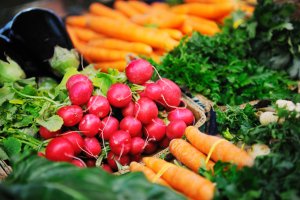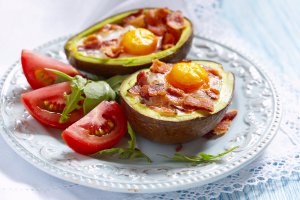A Ketogenic Vegan Diet might seem like a daunting task when it comes to food choices.
 But does it have to be?
But does it have to be?
The ketogenic diet has quickly become one of the most popular and effective ways to lose weight, improve cardiovascular health, and stay in shape for years. It focuses on using high-quality protein and limiting your carbohydrate intake in a way that forces your body into a unique state known as ketosis. As a result, you are often forced to eat high amounts of meat and fatty foods, such as almonds and thick soup broth.
Now, if you are a vegan who is interested in this diet, you might feel like you are entirely left out of all the fun. That’s not the case at all. In fact, the ketogenic vegan diet is available if you are willing to work hard and adjust your food intake in a variety of ways.
That said, this path isn’t going to be an easy one to follow. In fact, it might be one of the most stringent diets that you’ll ever try to master on your own. It is a challenge to both people who have mastered the demands of the ketogenic vegan diet and have been on it for years and those who are new to this eating style.
However, it is well worth it if you are struggling with your weight or want to balance your cholesterol levels. That’s why we’re going to examine this type of diet and provide you with the insight you need to master it.
In this article, you are going to learn about the origins of the ketogenic diet, how it has been adjusted to meet the demands of those on a ketogenic vegan diet, and the types of foods you can and cannot eat while losing weight with vegan ketosis. We’ll also mention a few high-quality exercises to help improve its effectiveness and get you into shape quickly.
The Origin of the Ketogenic Diet
 The ketogenic diet was officially created in 1924 by a man known as Dr. Russell Wilder. While high-protein diets had been eaten by a variety of cultures throughout the ages, Wilder set down the earliest standards for a strict, specific, and healthy dietary plan.
The ketogenic diet was officially created in 1924 by a man known as Dr. Russell Wilder. While high-protein diets had been eaten by a variety of cultures throughout the ages, Wilder set down the earliest standards for a strict, specific, and healthy dietary plan.
While ketogenic diets are mostly used now to lose weight, Wilder initially created this diet as a way of managing epilepsy in his patients. It was a very successful method for managing this problem and remained a popular treatment until more effective anti-seizure medications were invented in the 1940s.
As a result, the ketogenic diet wasn’t heavily studied or understood for years after its initial introduction by Wilder. However, various dietary experts discovered the power of ketosis and the ways that it helped to burn fat off of a person’s body. In some instances, it was used in obesity clinics as a way of quickly getting patients into shape.
However, it wasn’t long before some experts saw the potential for profit in this weight-loss plan. As a result, a growing number of protein-rich diets were created by various dietary specialists. The most famous of these is probably the Atkins Diet. This variation of ketosis was established in the 1990s and made its creator a millionaire.
Since the debut of Atkins ketogenic variation, a resurgence in interest for this particular diet has occurred. For example, The Charlie Foundation was formed in 1990 after a young man, Charlie Abraham, used a strict ketogenic diet to beat seizures that happened after a failed brain surgery while he was a baby.
Keeping his body in ketosis not only helped keep him free of seizures for most of his life, but it also kept Abraham safe from excessive weight gain and helped him become a successful young college student.
What is Ketosis?
 We’ve mentioned ketosis a few times in this article, so now is probably a good time to describe how it affects your body. Ketosis occurs when your body has burned all of the sugar generated by carbohydrates. At this point, your body fears that you are starving and starts converting the fat in your body into energy. Rather than metabolizing sugar to provide energy for its operation, the body will start converting fat into fatty acids and ketone bodies.
We’ve mentioned ketosis a few times in this article, so now is probably a good time to describe how it affects your body. Ketosis occurs when your body has burned all of the sugar generated by carbohydrates. At this point, your body fears that you are starving and starts converting the fat in your body into energy. Rather than metabolizing sugar to provide energy for its operation, the body will start converting fat into fatty acids and ketone bodies.
In a real starvation situation, your body will draw on your fat reserves and burn through them quickly to keep you healthy and active. It gave our cavemen ancestors enough time to hunt for food or pick berries and vegetables to eat. However, sticking to this type of diet forces you to ignore sugar energy and to get all of your power from the fat you eat every day.
Yet, ketosis will still burn the fat stores in your body. As a result, you’ll notice your glucose and cholesterol levels rapidly decreasing. Even better, you’ll improve your insulin resistance and suffer from fewer bouts of confusion or low energy.
Kicking your body into the ketogenic state requires a significant dietary change that includes eliminating almost all types of carbohydrates from your body and your regular food intake. While you’ll still be allowed to eat a small amount every day, it’ll be a fraction of what you are used to eating.
For example, a typical ketogenic diet lets you consume 20 grams of carbohydrates every day. Before you switched to this diet, there’s a good chance you were eating nearly 200 or even more carbs every day.
As you can imagine, this change in your food intake is a real challenge and something that many people struggle to master. Even worse, those who are vegan probably look at a standard meat-heavy meal suggestion for a ketogenic diet and believe it is impossible for them to learn.
After all, one of the most popular ketogenic dietary books of the last 10 years was called “Eat Bacon: Don’t Jog.” As a vegan, you don’t have the option to eat bacon or other types of meat. Whether you are a vegan for health or ethical reasons, chowing down on fatty meat is simply not something you can do.
However, learning about the nature of a ketogenic diet can help you fully understand that meat, eggs, and cheese are not the only way to enter ketosis. In fact, there are plenty of foods that a vegan can eat to kick their body into ketosis. Before discussing them, though, let’s take a look at the way a ketogenic diet works, how a ketogenic vegan diet type will differ, and take a look at a few studies that confirm the effectiveness of this plan.
The Way a Ketogenic Diet Works
 A ketogenic diet works by eliminating almost all of the carbohydrates that you eat on a daily basis. For example, you won’t be able to eat oatmeal in the morning or a tofu sandwich for lunch. However, it can run even deeper than that and in ways that surprise you. For example, your delicious chocolate bar will have to be eliminated from your diet because it’ll contain high amounts of sugar.
A ketogenic diet works by eliminating almost all of the carbohydrates that you eat on a daily basis. For example, you won’t be able to eat oatmeal in the morning or a tofu sandwich for lunch. However, it can run even deeper than that and in ways that surprise you. For example, your delicious chocolate bar will have to be eliminated from your diet because it’ll contain high amounts of sugar.
One thing that is important to remember before starting this diet is the fact that you are cutting sugar, but not fiber, from your food. This point is important to remember because it can dictate many aspects of your meal selection.
For example, let’s say you want to eat a granola bar that has 25 grams of carbohydrates. While some ketogenic diets allow you to have as many as 50 grams, others may restrict you to as little as 20 grams.
As a result, you may think that you are eating half or even over 100 percent of your daily carbohydrates in this simple granola bar. Before making that assumption, take a look at the fiber and sugar count on the nutrition label.
In a good granola bar, you may find that 15 grams of the carbohydrates are fiber. In this instance, your net carbs would be just 10 grams. That’s because you would subtract your 15 grams of fiber from the 25 gram total.
As a result, the negative impact of this granola bar is significantly reduced. This fact also means that you can eat carbs that have very few, if any, sugars and which are high in fiber. A fiber-rich diet is something most vegans are familiar with and which they may naturally obtain by eating healthy vegetables and fruits. As a result, it can be more comfortable for vegans to transition to a ketogenic diet than it is for people who do not have a vegan lifestyle!
Studies Confirm Their Benefits
 By now, you may be wondering if this diet is too good to be true. After all, so many so-called diet plans use pseudo-science explanations to convince people they are worth their time. Thankfully, there is great scientific backing for the ketogenic diet and its effectiveness. We’ll take a look at just one to give you a feel for the kind of studies that have confirmed the effectiveness of this dietary plan.
By now, you may be wondering if this diet is too good to be true. After all, so many so-called diet plans use pseudo-science explanations to convince people they are worth their time. Thankfully, there is great scientific backing for the ketogenic diet and its effectiveness. We’ll take a look at just one to give you a feel for the kind of studies that have confirmed the effectiveness of this dietary plan.
The study we examined was published as “Ketogenic Diet for Obesity: Friend or Foe?” and gauged how well ketosis helped a person burn fat. It also tested if ketogenic diets helped improve cardiovascular problems. This particular study not only compiled information from other studies on this subject but did a new study to test other benefits of this dietary adjustment.
The results of this study were almost overwhelmingly positive. Researchers stated that ketosis has a real physiological and biochemical basis. In fact, they believed that introducing this kind of diet to a person suffering from obesity could help them lose weight without any other lifestyle changes. They also found that people on this diet had decreased risk of serious cardiovascular problems.
However, they also emphasized the fact that a ketogenic diet requires severe lifestyle changes. It can also cause harmful side effects, such as constipation. In severe cases, a person may suffer from an impacted bowel caused by excessively hard fecal matter.
That said, people on a ketogenic vegan diet who are avoiding meat, cheese, and other dairy products are less likely to suffer from this problem. In fact, let’s transition to a look at a vegan ketogenic diet to give you an insight into just how different it is than the traditional method.
How a Ketogenic Vegan Diet Differs
 The main way that a ketogenic vegan diet differs from a traditional one is the type of foods that you will eat. The traditional ketogenic diet focuses heavily on meat, cheese, and other dairy products. That’s because these foods are the highest in protein and have the most fat. However, vegans like you obviously cannot eat these kinds of foods.
The main way that a ketogenic vegan diet differs from a traditional one is the type of foods that you will eat. The traditional ketogenic diet focuses heavily on meat, cheese, and other dairy products. That’s because these foods are the highest in protein and have the most fat. However, vegans like you obviously cannot eat these kinds of foods.
Instead, you’ll be focusing on foods that are low in carbohydrates and high in protein. For example, broccoli has almost no sugar and a high amount of protein. While it doesn’t have a lot of fat, you can get by that by smothering it in a healthy butter substitute, like ghee. Later on, we will discuss the foods that you can eat on this diet in more depth, including alternatives that add fat to your diet without breaking your vegan lifestyle.
For now, let’s understand the basic rules that dictate a ketogenic vegan diet. Just like a typical ketogenic diet, a vegan variation will follow a few concepts that are worth listing out here:
- Limiting carbohydrates to between 20-50 grams every day
- Avoiding sugars and sugar substitutes completely
- Eating as much protein and fat as you want with every meal
- Staying away from beer and other alcoholic beverages
- Drinking mostly water, tea, and other sugar-free drinks
- Sticking to fruits and vegetables with low sugar content
The latter point may be tough for many vegans to follow. After all, this means you’re going to have to cut out some of your favorite fruits, such as oranges and kiwis. However, there are still plenty of great fruits that are relatively low in sugar. For example, most berries are usually very low in sugar and can be added to many types of meals.
In fact, it is worth talking briefly about this point to emphasize it even further. On a ketogenic vegan diet, your fruits are likely to make up all of your carbohydrates. Unfortunately, you just aren’t going to have many carbs to spare. And eating fruit is infinitely healthier than focusing on heavy grains and other carbohydrates sources.
If you end up cutting all other carbs out of your diets besides fruits, it is essential to take fiber supplements. This action can avoid serious side effects, such as the level of constipation we mentioned earlier. While you should still be getting fiber from your other snacks or foods, a supplement can increase your level even further.
A Look at a Ketogenic Vegan Diet Study
We already briefly touched on a study showcasing the benefits of a traditional ketogenic food plan. However, it is worth taking a look at a study that showcased the benefits of a ketogenic vegan diet variation.
This scientific examination started with the presumption that ketosis was a beneficial way to lose weight. However, it expanded on this concept by assessing how effective it could be for those who stuck strictly to a vegan diet.
It took a look at several variations of the ketogenic vegan diet that used only vegan food sources. For example, it tested the effectiveness of gaining fat from gluten and soy products. A few of the other foods it tested included nuts and vegetable oils.
The purpose of the study was to see whether this variation of the ketogenic diet was more effective for weight loss than a high-carbohydrate and low-fat diet. Ketosis from a vegan diet was also gauged for benefits to your heart health.
The conclusion this review reached was very definite. Thes researchers found that a self-selected diet of this type lowered your lipids more quickly than a standard low-fat dietary plan. This benefit existed in spite of the fact that people ate fat on this diet at a much higher level than on a high-carbohydrate diet. As a result, they believed that eating these types of foods could decrease heart disease risk factors and even help a person lose weight more quickly.
At this point, you are probably pretty excited about the potential of a ketogenic vegan diet. We don’t blame you! Being able to lose weight and improve your heart health while eating fat sounds like a fantastic plan to us.
However, you need to understand the kinds of foods that you can eat while on this diet. While it may not require as much personal dietary adjustment for someone who eats meat, switching to a ketogenic vegan diet food plan may still be a challenge for you.
The Foods You Can (and Can’t) Eat on the Ketogenic Vegan Diet
 The unique dietary needs of a ketogenic vegan diet make it one of the most restrictive diets available today. That said, a dedicated vegan can stick to it if they understand what foods they are allowed to eat. You also need to understand the other restrictions that make this diet so tough. While we already discussed the rules of a typical ketogenic diet, these variations make a vegan one even tougher:
The unique dietary needs of a ketogenic vegan diet make it one of the most restrictive diets available today. That said, a dedicated vegan can stick to it if they understand what foods they are allowed to eat. You also need to understand the other restrictions that make this diet so tough. While we already discussed the rules of a typical ketogenic diet, these variations make a vegan one even tougher:
- Eating less than 35 grams of carbs every day
- Focusing on low-carbohydrate vegetables
- Consuming 70-percent of your calories from plant-based fats
- Filling the rest of your diet with plant-based proteins
- Adding a supplement for D3, B12, B6, DHA, EPA, iron, zinc, and taurine to avoid vitamin deficiencies
One of the toughest parts of the ketogenic vegan diet is that you aren’t going to be able to eat any grain on this diet. As a result, you can say goodbye to cereal, corns, and rice. Even worse, you also can’t eat legumes on this diet either. There goes all beans, lentils, and peas. Perhaps worst of all, fruit, such as apples and bananas are also out.
Less devastating for most people is the fact that tubers, such as potatoes and yams, are also gone from your diet. And we’re sorry to say it, but delicious honey, agave, and maple syrup must also be eliminated when you are on this diet.
We know that sounds brutal and limiting for many vegans. In fact, there are no other words for it than those. Adjusting to this routine is not going to be easy and will truly challenge even the most dedicated vegans. However, there are still quite a few foods that you can eat on this diet, including:
- Tempeh
- Tofu
- Seitan
- Mushrooms
- All leafy greens, such as spinach and kale
- Vegetables grown above the ground, like cauliflower and broccoli
- High-fat dairy alternatives
- All nuts and seeds, particularly almonds and pistachios
- Fermented foods, such as sauerkraut
- Sea vegetables, like seaweed and kelp
As you can see, there are still plenty of delicious foods that you can eat on a vegan ketogenic diet. Yes, you are going to be restricted and will lose out on the delicious rice that helped make life so enjoyable. Even worse, you can’t eat those protein-rich beans that helped replace meat when you turned vegan.
However, there are many other substitutes that you can use to expand your ketogenic vegan diet. Understanding these high-quality foods can provide you with a more vibrant and more diverse menu for your weight loss plan. Let’s take a look at a few below to give you a better way to eat.
High-Quality Substitutes That Make a Ketogenic Vegan Diet Easier
If you are struggling to get enough fat on this diet, it is important to understand a few delicious substitutes. These can help make your life easier by providing you with the high-fat intake you need for a ketogenic diet. Even better, they can expand your food intake to make it more delicious and enjoyable. Just a few foods that you can enjoy include:
- Coconut milk
- Coconut cream
- Vegan butter or coconut oil
- Vegan cheese
- Nut-based yogurt
- Flax seeds
- Silken tofu
- Olive oil
- Avocado oil
- Red palm oil
- MCT oil
- Avocado
- Nuts
- Most seeds
- Vegan protein powders
Each of these foods is high in protein and particularly rich in fat. Adding them to your ketogenic vegan diet will make it easier for you to get the fat that you need to start ketosis. They can also help you avoid carbohydrate withdrawal or cravings by simulating the texture and taste of many common carbohydrates. In this way, you can stay healthy and on the path towards full ketosis.
A Typical Ketogenic Vegan Diet Meal Plan
We have created a simple meal plan that may make it easier for you to get into ketosis and stay there. While we won’t discuss any recipes for these foods, we will showcase a few foods that you should eat throughout the day. We broke your food consumption down into three meals and two snacks to eat between meals. This plan ensures you get the food you need to be healthy:
- Breakfast – Tempeh or tofu fried with olive oil, almonds covered with coconut milk, and deep-fried seaweed
- Snack – A handful of berries paired with some vegan cheese
- Lunch – A healthy spinach salad that includes various sea vegetables, mushrooms, and chopped seitan
- Snack – A handful of pistachios to fill you up before dinner
- Dinner – Tofu mixed with mushrooms, broccoli, and cauliflower and pan-fried with vegetable oil, served with any other foods you missed to balance out your diet
If this meal plan is too hard to master, you can also try the once-a-day ketogenic dining option. With traditional keto plans, a person can often eat all of their food in one sitting and avoid hunger pangs throughout the day. That’s because their body will have all the energy it needs to run and won’t need to activate the hunger urge to get more sugar and carbohydrates.
This type of meal plan is a good idea if you have a limited time to eat during the day or just don’t want to bother preparing multiple meals. You should be ready, however, to have bigger than usual bowel movements if you eat in this way. In fact, you are also going to need to ingest regular fiber supplements to ensure that you don’t cause yourself severe bowel problems.
Exercises That Help Improve a Ketogenic Vegan Diet Effectiveness
If you want to increase the effectiveness of your ketogenic vegan diet, it is important to exercise on a nearly daily basis. While switching to ketosis will help you lose weight without exercise, pairing it with this diet will make it even more effective. The best way to lose weight on this dietary plan is to focus on strength-building exercises.
That’s because they will trim and build your muscles and make it easier for you to lose weight. Muscles burn more resting calories than fat, making it easier for you to increase the effectiveness of this keto routine.
Here is a typical workout schedule that will work for many different people:
- Day One – Barbell bench press, one-armed dumbbell row, one-arm incline press, dumbbell curl, lying triceps extension
- Day Two – Back squat, rack pull, pallof press, sliding leg curl, Farmer’s Walk, neutral-grip chin up, overhead dumbbell press, body saw, face pull, hammer curl
- Day Three – Vary the exercises performed above with various leg routines, such as squats, weight-leg lifts, and more
- Day Four – Switch to cardio routines for the rest of the week, focusing this day on 15-25 minutes of hill sprints
- Day Five – Perform simple cardio routines, such as jumping rope or walking, for about 30-60 minutes
- Day Six – Take the whole day off and enjoy yourself
- Day Seven – Restart the strength exercises of day one
Try to exercise for at least 30 minutes every day. Even on your rest day, it’s not a bad idea to do something as simple as standing up while you watch television. This simple action will keep you from sitting and getting stiff. Make sure to begin and end every routine with dynamic stretches. These will help keep your muscles and your body from getting stiff or uncomfortable.
These routines are great because they increase your body’s energy needs and boost your fat burn even more. The exact calorie count of each exercise is also less critical with this routine because of your ketogenic diet.
That’s because an exercise’s caloric intake only matters when you are subsisting on carbohydrate and sugar energy. You can eat double the calories on a ketogenic vegan diet and find yourself still losing weight without exercise. And with exercise, you’ll be burning fat even faster.
That said, you are likely to be eating fewer calories on this type of diet because you’ll be more satisfied when eating ketogenic foods. High-protein foods fill you up and keep you from getting hungry so quickly. Even better, they are typically high in fiber and other vital elements. As a result, your metabolism will be faster, and you’ll lose weight even more quickly.
As always, though, make sure to talk to your doctor about any serious lifestyle changes. Suddenly jumping into an extreme exercise routine may be too hard for your body to handle. For example, it can cause a variety of problems, including:
- Confusion and exhaustion
- Difficulties sleeping
- Injured joints
- Increased or erratic heart rates
Talking to your doctor can help you find an exercise routine that is safe for your level of personal fitness. Easing into a routine in this manner also allows you to increase the exercise intensity and improve your fitness exponentially. It may take a little time to reach a high level, but you can reach that plateau and even expand on it if you are willing to work hard and stay consistent.
Getting Into a Ketogenic Vegan Diet
As you can see, the ketogenic vegan diet is a high-quality alternative eating method that is perfect for those who want to be healthier. All the fat that you consume will be converted into extra energy and keep you happier and healthier. Even better, it will burn a lot of fat off of your body and provide you with a clearer mind, decreased cholesterol levels, and much more.
When getting started on the ketogenic vegan diet, it is essential to do it in stages. While you are probably already eating a lot of these foods, you can suffer from what is known as carbohydrate withdrawal when you stop eating that food type. This situation occurs if your diet was high in the starchy foods we mentioned above.
While this kind of withdrawal is nowhere near as dangerous or painful as caffeine, alcohol, or opium withdrawal symptoms, it can cause an upset stomach, confusion, and a lack of energy. Thankfully, it should pass after no more than a day or two.
The one problem you’ll find, though, is that you’ll crave carbs for at least a week or so after you stop eating them. That’s because your body still wants to get the majority of its energy from carbohydrate sugars. Once ketosis kicks in, though, you’ll quickly find that you won’t crave those starchy foods anymore.
In fact, you’ll see yourself getting swiftly stuffed if you do try to eat those foods. You may also notice that you feel heavy, stuffed, or otherwise sick after eating too many carbohydrates.
These symptoms are easy to ignore once you find your body has fallen into ketosis. You won’t have the same need for carbohydrates that you possessed before you changed your food intake.
Even better, you’ll notice that fat is burning off of your body quickly and without much effort on your part. So don’t hesitate to try out the excellent weight-loss power of ketosis to get into shape faster and more permanently than you’ve ever experienced before.
As you can see, the ketogenic vegan diet can be a great lifestyle and doesn’t have to be as restricted as one may think.
Check out our complete guide to the Ketogenic Vegan Diet.
Have more questions? Be sure to visit our community forums.
Resources
NCBI: Ketogenic Diet for Obesity: Friend or Foe?
Charlie Foundation: Introducing the Diet
Greatist: 10 Complete Proteins Vegans Need to Know About
Health: 14 Best Vegan and Vegetarian Protein Sources
Table of Contents